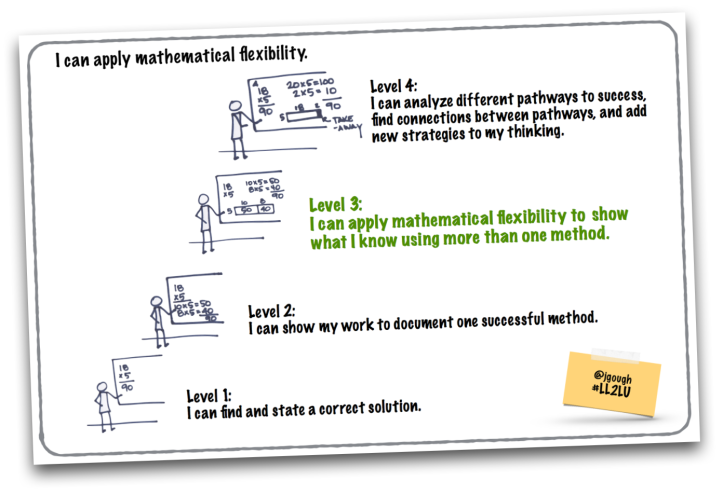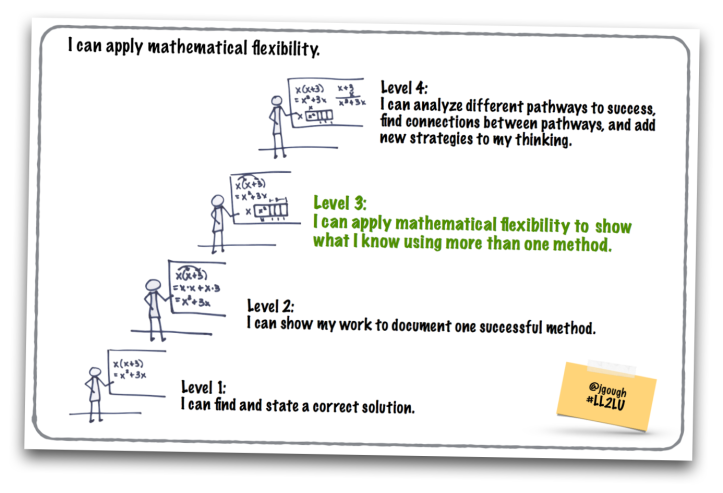From Jo Boaler’s How to Learn Math: for Students:
People see mathematics in very different ways. And they can be very creative in solving problems. It is important to keep math creativity alive.
and
When you learn math in school, if a teacher shows you a method, think to yourself, what are the other ways of solving this? There are always others. Discuss them with your teacher or friends or parents. This will help you learn deeply.
I keep thinking about mathematical flexibility. If serious about flexibility, how do we communicate to learners actions that they can take to practice?
How might we narrow what separates high achievers from low achievers? If number flexibility is a gateway to success, what actions are we willing to take to encourage, build confidence, and illuminate multiple pathways to success?


Jill,
You are speaking my language!!!! I really like the levels you have described here and the fact that finding a solution in one way is the baseline, if you will. I wonder how teachers will work with students on mathematical flexibility. I worry that teachers– especially elementary base teachers who haven’t had as much training or passion about math– are not as comfortable and confident in their own mathematical flexibility. Will they teach the different methods but yet fall back on the traditional method in either assessments or their own explanations? How might they “live” the flexibility in their classroom, celebrating each method/solution that children use in such a way that the teacher truly understands it, too?
LikeLike
The question raised here about teachers living flexibly in their math classrooms is a good one! It’s all about being willing to take risks and potentially fail publicly. I plan on using “Number Talks” to build flexibility and number sense. I also plan to make more student work public and available for feedback from peers. My hope is that this will encourage and celebrate flexibility, for me, other teachers, and students.
LikeLike
Sounds like a plan, Kato! The more math talk you have with the students, the more their comfort level and confidence will increase- and yours, too! I am proud that you are serving as such a strong model for your fellow teachers at Trinity!
LikeLike
Angél, This connects to one of our summer reading choices, 5 Practices for Orchestrating Productive Mathematics Discussions by Margaret Schwan Smith Mary Kay Stein. The first of the 5 practices is anticipating what learners might do, think, try. How we might anticipate what another might do requires flexibility in our own thinking. This leads to the necessity of teaming. If I share what I think with you, and you with me, I add to my toolkit of ideas. It takes practice and sharing for sure.
LikeLike
[…] progression. Could I integrate geometric and algebraic reasoning to confirm structure? How flexible am I as a mathematical thinker? I lack confidence with geometric representation using algebra […]
LikeLike
[…] if we extend the idea of interacting with numbers flexibly to interacting with appropriate tools flexibly? How many ways and with how many tools can we […]
LikeLike
[…] if we extend the idea of interacting with numbers flexibly to interacting with appropriate tools flexibly? How many ways and with how many tools can we […]
LikeLike
[…] Visual: Encouraging mathematical flexibility […]
LikeLike
[…] we are always working on our Mathematical Flexibility, and while I was pleased that everyone can get a definite integral, I was disappointed that they […]
LikeLike
[…] task is a good one for working on math flexibility. You can construct the hexagon one way? Great! Now find another way to construct the […]
LikeLike
[…] on your mathematical flexibility to come up with more than one way to construct the line of […]
LikeLike
[…] find someone who answered like you did. Share your arguments. Make yours stronger. Practice applying your math flexibility. (Thanks to Andrew for this idea in particular. I’ve had students partner with others with […]
LikeLike
[…] work on your mathematical flexibility. Instead of being satisfied with one way to answer, find multiple […]
LikeLike
[…] led to a discussion about working on our math flexibility throughout the […]
LikeLike
[…] for and make use of structure in ways they hadn’t thought to before. Everyone worked on their mathematical flexibility to find more than one way to determine the areas of the figures. Everyone learned at least one new […]
LikeLike
[…] Consider this learning progression on mathematical flexibility from Jill Gough. […]
LikeLike
[…] a fraction a/b on a number line diagram by marking off a lengths 1/b from 0. AND I can apply mathematical flexibility to show what I know using more than one […]
LikeLike
[…] used Jill’s learning progression so that students could self-assess where they were throughout the […]
LikeLike